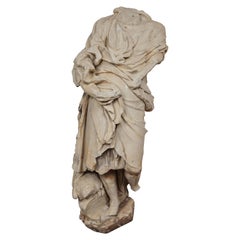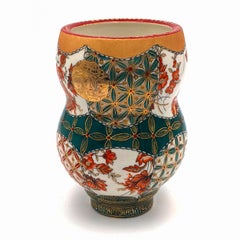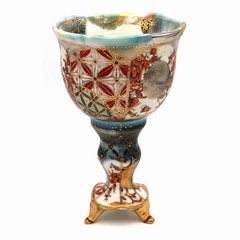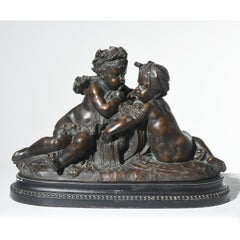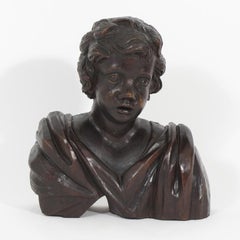Baroque Sculptures
Style: Baroque
Color: Brown
Renaissance Era Marble Figure Fragment
Located in Newport Beach, CA
An extraordinary 17th century, hand-carved, solid Carrara marble, life sized figure fragment on raised base of the same. The subject is swaddled in a luxurious, gathered robe and tun...
Category
17th Century Baroque Sculptures
Materials
Marble
A pair of late 17th century Northern European carved oak angels
Located in Bath, Somerset
A pair of carved oak angels, circa 1700, with a lovely warm patina and faint traces of polychrome to the face and gilding to the body. The angels are both kn...
Category
17th Century Baroque Sculptures
Materials
Oak
Small Vase (MADE TO ORDER) (Hand-painted, hand-made, porcelain)
Located in Kansas City, MO
(MADE TO ORDER) (Hand-painted, hand-made, porcelain)
*Lead Time may vary between 1-3 weeks
Melanie Sherman
"Small Vase"
Year: 2021
Porcelain, Glaze, China...
Category
2010s Baroque Sculptures
Materials
Luster, Porcelain, Glaze
Just A Little Tipsy (MADE TO ORDER) (Sabbath, Kiddush, Unique, Gold Luster)
Located in Kansas City, MO
(MADE TO ORDER) (Sabbath, Kiddush, Unique, Gold Luster)
*Lead Time may vary between 1-3 weeks
Melanie Sherman
"Just A Little Tipsy"
Year: 2021
Porcelain, Glaze, ChinaPaint, 24k Germ...
Category
Late 17th Century Baroque Sculptures
Materials
Luster, Porcelain, Glaze
Tuscan Baroque Nude Putto Candle Holder 17-18 century gilded wood
Located in Florence, IT
One flame candle holder putto made of gilded wood.
Those kind of objects were present in churches or noble villas, specially during the Baroque times.
The base is not coeval.
Category
17th Century Baroque Sculptures
Materials
Gold
"Putti" 19th c. Terracotta, Antique, Mythical Figures, Patina
Located in Detroit, MI
SALE ONE WEEK ONLY
“Putti” is a 19th c. terracotta antique of two nude children, babies, as mythical figures. This piece is beautifully rendered with a...
Category
Late 19th Century Baroque Sculptures
Materials
Terracotta, Wood
Late 17th C, Baroque, Saint, Italian School, Wooden Sculpture of Saint Anthony
Located in brussel, BE
The impressive life-size statue of St. Anthony (Lisbon, 1195 – Padua, 1231) used to be probably in a church or monastery of the mendicant order of the Franciscans. You can immediately recognize a Franciscan monk by his brown habit, brown hooded cloak...
Category
17th Century Baroque Sculptures
Materials
Wood
Rare and Important Italian Alabaster Bust Sculpture of Jesus Christ, C. 1860
Located in New York, NY
A rare and important Italian alabaster bust sculpture of Jesus Christ, C. 1860
A modeled bust of Holy Christ wearing a crown of thorns, exceptional...
Category
19th Century Baroque Sculptures
Materials
Alabaster
Related Items
Contemporary Porcelain and Earthenware Sculpture with Glaze and Luster
Located in St. Louis, MO
Paul McMullan's work combines the surreal with the sublime; referencing imagery and objects we encounter in our every day lives, but collaged together in such a way that prompts the ...
Category
2010s Baroque Sculptures
Materials
Ceramic, Clay, Earthenware, Glaze, Luster
Nymph And Satyr Pair Of Sculptures Busts By Lanzirotti Signed Terracotta 19th
Located in Roma, IT
Pair of important Terracotta busts depicting the Satyr and the Nymph by Antonio Giovanni Lanzirotti (Naples, 9 May 1830 – 1921) signed on the back.
Antonio Giovanni Lanzirotti was ...
Category
19th Century Baroque Sculptures
Materials
Terracotta
No Reserve
H 9.85 in W 7.09 in D 4.73 in
Quinto Martini Female Nude Sculpture 20 century terracotta signed.
Located in Florence, IT
This small terracotta statue portrays a lady laying on a very sensual and athletic position. Is signed on the base Quinto M. Even if it's not dated, we can premusably suggest a perio...
Category
Mid-20th Century Baroque Sculptures
Materials
Terracotta
Vintage Peacock I (Wall Piece/Dish) (MADE TO ORDER) (~50% OFF LIMITED TIME ONLY)
Located in Kansas City, MO
(MADE TO ORDER) (Hand-painted, hand-made, porcelain)
*Lead Time may vary between 1-3 weeks
Melanie Sherman
Vintage Peacock I (Wall Piece/Dish (handpainted)
Porcelain, Glaze, Overglaze, Chinapaints, 24k German Gold Luster, Brass Wire (for hanging, can be removed)
Year: 2022
Size: 4.5x6x0.5in
Signed by hand
COA provided
Ref.: 924802-1330
------------------------
My ceramics are handmade and painted with the finest overglazes from Europe. The gold luster used is 24k liquid Gold from Germany. Every piece is unique. My imagery is inspired by vintage Meissen dinnerware...
Category
2010s Baroque Sculptures
Materials
Brass
Vintage Cobalt Blue and Gold Trim Limoges Porcelain Trinket Box France
Located in East Quogue, NY
Beautiful vintage cobalt blue lidded porcelain trinket jewelry box with gold hand-painted floral decorative rim. The central illustration is of a couple dressed in Louis XVI period s...
Category
Mid-20th Century Baroque Sculptures
Materials
Ceramic, Porcelain
French Terracotta Sculpture Studio Torso Belvedere Grand Tour Style 19th Century
Located in Roma, IT
a very interesting sculpture, a studio of the Belvedere Torso made in french in the 19th Century. Standing on a double order circular wood base, the sculpture present an harmonic and...
Category
19th Century Baroque Sculptures
Materials
Terracotta, Wood
No Reserve
H 12.6 in W 8.67 in D 9.85 in
Vintage Peacock III (Wall Piece/Dish (hand-painted, made to order by the artist)
Located in Kansas City, MO
Melanie Sherman
Vintage Peacock III (Wall Piece/Dish (handpainted)
Porcelain, Glaze, Overglaze, Chinapaints, 24k German Gold Luster, Brass Wire (for hanging, can be removed)
Year: 20...
Category
1790s Baroque Sculptures
Materials
Brass
Terracotta figurativa italiana a tema mitologico dei primi del Novecento
Located in Florence, IT
Piccola terracotta a soggetto mitologico firmata sul retro sulla base "Zambini", che per la grafia (in particolare la Z che ricorda una F) permette di identificare l'artista con Ferr...
Category
Early 20th Century Baroque Sculptures
Materials
Terracotta
Roman 18th century terracotta model for the sculpture of San Camillo de Lellis
Located in London, GB
This remarkably fluid terracotta bozetto was made in preparation for Pietro Pacilli’s most important public commission, a large-scale marble statue of San Camillo de Lellis for the nave of St Peter’s Basilica in Rome. Expressively modelled, this terracotta sculpture is a rare and significant work made by a major Roman sculptor at a transformative moment of European sculpture. Pacilli began his working life on the great Baroque decorative projects initiated in the seventeenth century, but he found success as a restorer of ancient sculpture working to finish antiquities for a tourist market, becoming an important figure in the emergence of an archaeologically minded Neoclassicism. Pacilli trained Vincenzo Pacetti and provided important decorative work for the Museo Pio-Clementino, at the same time he is recorded restoring some of the most celebrated antiquities excavated and exported during the period.
Pacilli was born into a family of Roman craftsmen, his father Carlo was a wood carver, and Pacilli is recorded working with him on the Corsini Chapel in San Giovanni Laternao as early as 1735. In 1738 his terracotta model of Joseph and Potiphar’s Wife won the first prize in the second class of the sculpture concorso at the Accademia di San Luca, this is particularly notable as Bartolomeo Cavaceppi came third. He worked as a carver and stuccoist completing works for the churches of San Marco and SS. Trinita dei Domeniciani Spagnoli. Pacilli operated as a sculptor and restorer of antiquities from his studio at the top of the Spanish Steps, close to Santa Trinita dei Monti, where he is listed as a potential vendor to the Museo Pio-Clementino in 1770.
In 1763 Pacilli completed a silver figure of San Venanzio for the treasury of San Venanzio. He is recorded as Pacetti’s first master and it was evidently through Pacilli that he began to acquire his facility as a restorer of ancient sculpture. Pacilli, at his studio ‘poco prima dell’Arco della Regina alla Trinita dei Monti,’ exercised, what the nineteenth-century scholar, Adolf Michaelis called ‘rejuvenating arts’ on several important pieces of classical sculpture, including in 1760 the group of a Satyr with a Flute for the natural brother of George III, General Wallmoden, Hanovarian minister at Vienna. In 1765, Dallaway and Michaelis record that Pacilli was responsible for the restorations, including the addition of a new head, to the Barberini Venus which he had acquired from Gavin Hamilton. The Venus was then sold to Thomas Jenkins, who in turn passed it on to William Weddell at Newby Hall. In 1767 Pacilli exported a series of ancient busts ‘al naturale’ including portraits of Antinous, Julius Ceaser and Marus Aurelius, also a statue of a Muse and a Venus. As early as 1756 Pacilli seems to have been operating as an antiquarian, helping to disperse the collection of the Villa Borrioni. Pacilli supplied sculpture to notable British collectors, including Charles Townley, who on his first trip to Italy purchased the Palazzo Giustiniani statue of Hecate from Pacilli. Pacilli was involved with the Museo Pio Clementino from its conception, supplying busts of Julius Ceaser and a Roman Woman as well as completing stucco putti surmounting the arms of Pope Bendedict XIV to signal the entrance to the new Museo Critiano.
In 1750 Il Diario Ordinario del Chracas announced that Pacilli had begun work on a sculpture of San Camillo de Lellis for St Peter’s. Camillo de Lellis founded his congregation, the Camillians, with their distinctive red felt crosses stitched on black habits in 1591. Having served as a soldier in the Venetian army, Camillo de Lellis became a novitiate of the Capuchin friars, he moved to Rome and established a religious community for the purpose of caring for the sick. In 1586 Pope Sixtus V formerly recognised the Camillians and assigned them to the Church of Santa Maria Maddalena in Rome. Camillo de Lellis died in 1614 and was entombed at Santa Maria Maddalena, he was canonised by Benedict XIV on June 26, 1746. It was an occasion that prompted the Camillians to make a number of significant artistic commissions, including two canvases by Pierre Subleyras showing episodes from San Camillo’s life which they presented to Benedict XIV. In 1750 Pacilli was commissioned to fill one of the large niches on the north wall of the nave with a sculpture of San Camillo.
The present terracotta bozetto presumably had two important functions, to enable Pacilli to work out his ideas for the finished sculpture and at the same time to show his design to the various commissioning bodies. In this case it would have been Cardinal Alessandro Albani and Monsignor Giovan Francesco Olivieri, the ‘economo’ or treasurer of the fabric of St Peter’s. Previously unrecorded, this terracotta relates to a smaller, less finished model which has recently been identified as being Pacilli’s first idea for his statue of San Camillo. Preserved in Palazzo Venezia, in Rome, the terracotta shows San Camillo with his left hand clutching his vestments to his breast; the pose and action more deliberate and contained than the finished sculpture. In producing the present terracotta Pacilli has expanded and energised the figure. San Camillo is shown with his left hand extended, his head turned to the right, apparently in an attempt to look east down the nave of St Peter’s. The model shows Pacilli experimenting with San Camillo’s costume; prominently on his breast is the red cross of his order, whilst a sense of animation is injected into the figure through the billowing cloak which is pulled across the saint’s projecting right leg. The power of the restrained, axial contrapposto of bent right leg and outstretched left arm, is diminished in the final sculpture where a baroque fussiness is introduced to the drapery. What Pacilli’s terracotta demonstrates, is that he conceived the figure of San Camillo very much in line with the immediate tradition of depicting single figures in St Peter’s; the rhetorical gesture of dynamic saint, arm outstretched, book in hand, head pointed upwards was perhaps borrowed from Camillo Rusconi’s 1733 sculpture of St. Ignatius...
Category
18th Century Baroque Sculptures
Materials
Terracotta
Contemporary Earthenware Sculpture with Gold Luster and Glaze
Located in St. Louis, MO
Paul McMullan was born in Rochester, New York. He received his M.F.A. from the New York State College of Ceramics at Alfred University in Alfred, New York and his B.F.A. from James M...
Category
2010s Baroque Sculptures
Materials
Earthenware, Ceramic, Luster, Mixed Media, Other Medium, Porcelain
H 18 in W 9 in D 9 in
17th C Polychromed fruitwood carved statue depicting Madonna, France.
Located in brussel, BE
An exceptionally beautiful antique French wood carving, made in the 17th century. It depicts Madonna standing with open offering arms .The...
Category
17th Century Baroque Sculptures
Materials
Wood
Sculpture Torso Belvedere Grand Tour Style 19th Century Terracotta Academical
Located in Roma, IT
a very interesting sculpture, a studio of the Belvedere Torso made in french in the 19th Century. Standing on a double order circular wood base, the sculpture present an harmonic and...
Category
19th Century Baroque Sculptures
Materials
Terracotta, Wood
H 12.6 in W 8.67 in D 9.85 in
Previously Available Items
19th Century Wall Mounted or Standing Cherub Sculpture
Located in Palm Beach, FL
Antique, sculptural wood bust of a young woman or prepubescent child with a haunting, innocent expression. Displays as a wall mount or standing sculpture. Expertly carved hair, face ...
Category
Late 19th Century Baroque Sculptures
Materials
Wood
Italian Hand Carved Wood Madonna and Child on Crescent Moon Religious Sculpture
Located in Firenze, IT
Extremely representative Northern Italian school hand carved wooden sculpture from early 18th century featuring a serene Madonna with child standing above the terrestrial globe and crescent moon.
This solid lime wood sculpture of a crowned Virgin Mary holding the Baby Jesus in her arms evokes the traditional motif of the Madonna and child, transmits calm and maternal sweetness and at the same time is extremely strong and rich in symbolic elements.
This wonderful religious sculptural group depicting the Madonna standing on the globe with the symbol of the crescent moon beneath her feet is an allusion to the Apocalyptic Woman (Rev. 12:1–5).
The devil under symbolically represented in the form of a dragon holding an apple in its mouth is a reference to the original sin.
Furthermore, the presence of this additional symbolic element can make us interpret the moon as a symbol of inconstancy here vanquished beneath the feet of the Virgin.
The Holy Mary turns her gaze downwards, whilst tenderly holding the child in her arms, who interacts with the viewer rather than with his mother. The richness of the superb carving continues on the base which is embellished by high relief sculpted winged cherub faces and a scroll with golden lettering in Latin referring to the Holy Virgin Mary.
The whole model is extremely pleasant, transmitting a sense of harmony, peace and calm. Both the Virgin and the Holy Child have an embossed silver sheet crown. The sculpture rests on a rectangular wooden socle added later.
This sculpture was probably once hung in a church or private chapel, maybe as a part of an altarpiece, since it retains the original antique hook in the back. This beautiful sculpture can now be hung on the wall again or remain on the base as a fine art piece sculpted in the round.
The sculpture is in overall good condition considering age and use, the wood has a wonderful color and grain and original patina. Very old restoration of both sides of the cresent moon...
Category
18th Century Baroque Sculptures
Materials
Silver, Iron
H 26.78 in W 11.03 in D 5.91 in
18th C, Late Baroque, Religious, Flemish Shool, Sculpture of an Angel
Located in brussel, BE
This elegant, beautifully polished angel holds his hands together as if in prayer. The sculpture may have been part of a wooden pulpit. The fact that the statue has been carefully wo...
Category
18th Century Baroque Sculptures
Materials
Oak
H 22.05 in W 14.57 in D 15.36 in
Baroque Spanish 17th Century Winged Angel early wood sculpture carving
Located in Norwich, GB
Everyone can do with an Angel, and this one is particularly lovely, depicted as a winged youth carrying a martyr's palm. Spanish in origin, he was sculpted in the 1600s, and has rema...
Category
17th Century Baroque Sculptures
Materials
Wood
H 11.82 in W 3.94 in D 3.94 in
Florentine Artist Mascherone fountain Figurative sculpture 18th century marble
Located in Florence, IT
The mascherone was used as a fountain and it was probably commissioned for the garden of a Villa. It can be dated to the end of the 18th beginning of the 19th century and it's inspir...
Category
Late 18th Century Baroque Sculptures
Materials
Marble
H 8.67 in W 7.49 in D 4.73 in
18th century Polychromed Statue of Saint Joseph
Located in Greenwich, CT
A fine polychromed and gilt Saint , 18th century Spanish colonial.
Presented in a wood carved niche
Category
18th Century and Earlier Baroque Sculptures
Materials
Wood
Baroque sculptures for sale on 1stDibs.
Find a wide variety of authentic Baroque sculptures available for sale on 1stDibs. Works in this style were very popular during the 21st Century and Contemporary, but contemporary artists have continued to produce works inspired by this movement. Many Pop art paintings were created by popular artists on 1stDibs, including Albert-Ernest Carrier-Belleuse, Antoine-Louis Barye, and Giovan Domenico Lombardi Omino. Frequently made by artists working with Stone, and Marble and other materials, all of these pieces for sale are unique and have attracted attention over the years. Not every interior allows for large Baroque sculptures, so small editions measuring 9 inches across are also available. Prices for sculptures made by famous or emerging artists can differ depending on medium, time period and other attributes. On 1stDibs, the price for these items starts at $1,140 and tops out at $138,000, while the average work sells for $7,834.
Recently Viewed
View AllMore Ways To Browse
Fruit Figurines
Outdoor Sculpture Art Deco
Outdoor Hanging Sculpture
Contemporary Wearable Art Jewelry
Bronze Airplane
Ancient Views Of Shanghai
Nu Sculpture
Samurai Cat
Japanese Cat Figurine
Minotaur Sculpture
Emergency Glass
Panda Sculpture
Noguchi Stone
Raw Minerals
Lee Bontecou
In Case Of Emergency
Abstract Bronze Sculpture Netherlands
Red Panda
